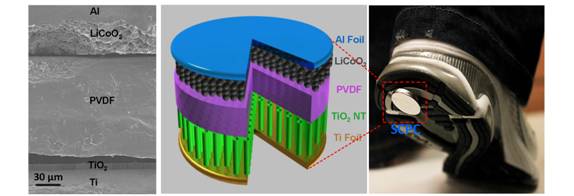Self-charging energy unit integrates energy conversion and storage
In the current world energy crisis, the search for green energy and renewable energy to replace traditional energy has become the most important research field, affecting the progress of human society. Among them, energy conversion technology and energy storage technology are the two most core technologies to solve energy problems. Energy conversion technology is used to convert different forms of renewable energy, such as solar energy, thermal energy, chemical energy and mechanical energy, into electrical energy through different mechanisms for people to use. On the other hand, energy storage technology can store the obtained electrical energy in a certain device to achieve more controllable and flexible electrical energy use, such as a lithium ion battery that can store electrical energy in the form of chemical energy. Under the existing technology, these two technologies are usually implemented based on discrete device units and different approaches. Taking the conversion and storage of mechanical energy as an example, two separate device units are usually required to separately convert mechanical energy into electrical energy and store electrical energy as chemical energy.
Recently, under the leadership of Professor Wang Zhonglin (foreign academician of the Chinese Academy of Sciences and chief scientist of the Beijing Institute of Nano Energy and Systems, Chinese Academy of Sciences), a research team composed of Xue Xinyu and Wang Sihong reported for the first time a completely new mechanism that converts energy and The two processes of storage are merged into one process, which means that the mechanical energy is stored in the form of chemical energy at the same time as the conversion. This is achieved through the ingenious device design, which fuses the nano-generator and the lithium-ion battery into an independent device unit—Self-Charging Power Cell. This self-charging energy unit can use the mechanical deformation and vibration in the environment to directly charge. The research results have recently been published in "Nano Letters" (Nano Letters).
The device structure design of the self-charging energy unit is based on the basic structure of the lithium ion battery (anode, separator, cathode and electrolyte), and the traditional polyethylene (PE) separator is made of polyvinylidene fluoride with piezoelectric effect ( PVDF) film instead. Under the action of external force, the PVDF diaphragm will produce longitudinal compressive strain, which in turn causes the PVDF film with the proper polarization direction to generate a piezoelectric electric field from the cathode to the anode. Driven by this piezoelectric electric field, lithium ions in the electrolyte will migrate from near the cathode to the anode to shield the piezoelectric electric field in the system. This will change the concentration of lithium ions in the electrolyte near the yin and yang poles, thereby breaking the balance of the redox chemical reaction at the two places, allowing the battery charging reaction to occur. Compared with the traditional battery charging method that uses a DC power supply to send electrons from the cathode to the anode through an external circuit, the self-charging energy unit drives the lithium ion movement within the system under the action of a piezoelectric electric field caused by mechanical action to initiate a charging reaction.
The experimental results show that under the action of 2.3 Hz periodic impact, the voltage of the self-charging energy unit can be increased by about 68 mV in 4 minutes, and the charged amount can be discharged with a current of 1 μA for 130 seconds. After comparison, under this completely new mechanical-electrochemical process, the total efficiency of energy conversion and storage of the self-charging energy unit is several times that of the traditional discrete device mode under the same conditions. This new energy conversion and storage mechanism provides new energy technologies for driving personal electronic products and self-driving systems.

Design, implementation and application of self-charging energy units. This two-step process of converting mechanical energy into electrical energy and then storing electrical energy as chemical energy is directly replaced by a one-step leap-forward process from mechanical energy to chemical energy, which can greatly improve the overall energy efficiency.
These gym folding mats are ideal for multiple exercise, not only for gymnastics but also for multiple lifestyle needs, and provides safe cushioning for yoga, Pilates, playroom flooring, stretching, wrestling, cheer, martial arts, MMA, indoor bouldering and other general exercises.Also it is ideal for teaching basic gymnastics and exercises to kids, they can practice tumbling, cartwheels and back handsprings.
According to the description of these functions, our products can be used in many place.
Incline Mat,Tri Fold Gym Mat,Exercise Mat Flooring,Foldable Gymnastics Mat
Shaoxing geili sports and leisure goods Co.,Ltd , https://www.geilisports.com